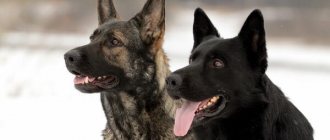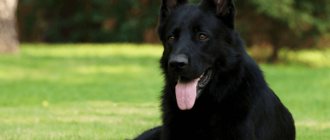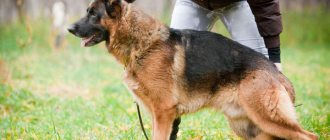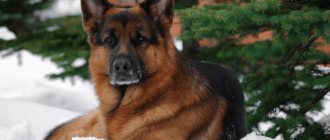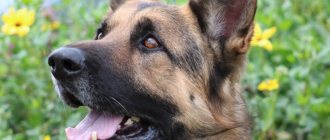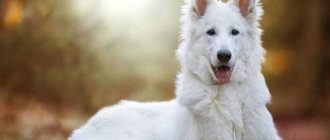- Reports
- Animals
- German Shepherd
The German Shepherd is a very common breed of dog. The main purpose of the German Shepherd is for exhibition purposes, it is an indispensable service friend in the police and the Ministry of Emergency Situations, and shepherds are also favorites in the home family circle.
This breed appeared in the 19th century. The main task of such dogs was to protect herds of animals. Thanks to its high endurance, stable, balanced psyche, and strong sense of smell, this dog began to be trained and used for police purposes and in the army.
During the years of the First and Second World Wars, this breed of dog showed itself properly and became man's best friend.
Currently, the German Shepherd is indispensable in the household; it ranks first among all dogs and is not inferior to any breed in competition. The German Shepherd is a unique and very intelligent dog. She can equally serve in the army, be a partner to a policeman, save people in case of fire and in the event of collapses and buildings, find drugs, guard a house, or accompany the blind and be a nanny for small children.
Despite the fact that German Shepherds are very strong and hardy, they are prone to certain diseases, namely joint diseases, eye diseases and allergies.
German Shepherds come in both smooth-haired and long-haired varieties. The coat color is different - black, red-brown, light gray, yellow-brown.
When entering a family, the main thing for a dog is to become loved and ideal for its owners. Dogs of this breed seem to take very good care of small family members and their safety. The devotion of these shepherds has more than once saved the lives of children when they were attacked by criminals. These dogs can also take good care of pets, such as cats. Shepherds love company very much; this breed of dog experiences loneliness very difficult - it howls and whines like a wolf, demanding attention.
Since the German Shepherd is a large breed, it can pose a danger to people. To avoid this, and for people to feel comfortable living next to such a dog, it needs to be trained. Shepherds are very smart and cunning animals, they are easy to train. A trained dog will never just attack people, but in case of danger, it will detain a criminal on command.
German Shepherds are a wonderful pet for kind and active people who appreciate the affection and love of their owners.
Interesting facts about the dog breed
- German Shepherds are distinguished by the fact that they are capable of performing a wide range of functions, so they can be found both in the service and as a family friend.
- This breed is characterized as flexible, intelligent and loyal, while understanding that the person is in charge.
- The German Shepherd breed is one of the three most intelligent dog breeds, which also includes border collies and poodles.
- They simply need physical activity, as well as communication with people.
- They perfectly find a “common language” with children of all ages.
- They can live indoors or in enclosures without problems.
- A shepherd dog can live for at least 9 years, but after 7 years of life, it is necessary to carry out comprehensive monitoring of the dog’s health.
The German Shepherd has always been at the top of rankings that include the smartest, most loyal and most trainable dog breeds. The faces of these animals can be seen in news shows, on newspaper pages and on the pages of magazines and books. Quite often, German Shepherds take part in various television shows. And yet, despite such a high authority of this breed, its main task is to maintain law and order. Therefore, German Shepherds are found in police departments, border and customs services, and also rescue people. At home, these dogs become full members of the family, protecting the peace and property of citizens, as well as the citizens themselves and their family members from outside attacks. At the same time, they help all family members cope with negative emotions, recharging themselves with positive ones.
Reproduction and lifespan
A reliable guard, a loyal friend and just a beautiful pet - all this describes the German Shepherd perfectly. She lives from 12 to 14 years, but only with good care. Breeders planning to breed these types of dogs should be well aware of their standard. It is also advisable to breed individuals of the same color. Only in this case can one raise offspring that are correct in every sense.
A male dog can be the same age as a female dog, the main thing is that each of them is over 1.5 years old. It is not advisable to have dogs over 7 years old. Each of the potential parents must be psychologically stable and of high breed.
They are mated in the male's territory. This happens when the bitch is in heat. If she becomes pregnant, then by 8-10 days after reproduction her tummy will be noticeably rounded. You can expect puppies in 70 days (plus or minus 3 days).
Historical data
In order to trace the pedigree of various types of breeds, even if they became known already in the 19th century, and even more so in the 20th century, it is enough to rummage through special documents or use eyewitness information. As for the German Shepherd breed, not everything is so simple, since experts say that the ancestors of this breed should be sought much deeper.
Archaeological data obtained as a result of excavations in the territories of some European countries indicate that back in the 4th millennium BC there were dogs whose skeletons were very similar to the skeletons of modern shepherd dogs. According to experts, their ancestors are wild individuals who lived near the sites of ancient people, as a result of which they began to obey the will of man.
Scientists also suggest that already in those days primitive breeding work was carried out, as a result of which preference was given to strong and obedient individuals.
The small Indian wolf, which no longer exists in our time, increasingly moved away from its independent relatives, eventually acquiring the status of Bronze Age dogs. As time passed, humanity gradually developed, as a result of which the needs of all humanity changed. Despite this fact, farmers and pastoralists have always been tied to a specific area. As a result, four-legged companions began to master new functions. Throughout Europe, and especially in the Middle Ages, it was customary to breed Hofwarts. Translated from German, this means “guardian of the yard,” although dogs also performed other functions not related to real estate protection.
In those days, the area was simply teeming with predators, and domesticated livestock needed protection. In addition, already in those days there were many who wanted to profit from other people’s goods. Man could not cope with his responsibilities on his own, especially when he had to graze numerous herds. Therefore, man had to take advantage of the capabilities of yard dogs. Not all dog breeds could cope with the protection of numerous flocks, but only those that were distinguished by endurance and intelligence. The problem was also to select and train the animal. Such dogs were so valuable that in those days, for killing a dog that was herding flocks of livestock, the culprit faced death punishment.
According to experts, animals of the Medieval period, including those of later eras, were significantly different from modern representatives of various breeds. In those days, the main attention was paid not to the shape of the body, but to the mental abilities of the animal and its endurance. No less important was the “psychological portrait” of the dog, which was always next to the person. As a rule, the shepherds were isolated for a long time, throughout the entire season of keeping the animals, so the dogs were in contact exclusively with the shepherds all this time. And here the most important thing is that the dogs unquestioningly perform their functions. Moreover, the dogs were supposed to become real friends and companions for the shepherds.
By the end of the 17th century, the main characteristics of herding dog breeds began to appear. Two regional breeds have become widespread: the semi-long-haired Thuringian dogs with a curled tail and a fawn-gray color, as well as the long-haired Württemberg dogs with semi-erect ears, distinguished by a black or red color. These 2 breeds also differed in their behavior. If the former were considered very active animals and often barked loudly, then the latter were calmer and more resilient. Therefore, the breeders decided to join forces to develop a completely new breed of dog.
A lot of time passed and at the end of the 19th century the result of long and painstaking work was presented to the general public. In 1882, Baron von Knigge presented two of his pets at the Hanover Exhibition. Interest in the new breed arose with renewed vigor when the owners of the Hannau kennel showed off their impressive pair. Thanks to this couple, at least 2 dozen champions and winners of subsequent dog shows were born.
In 1891, it became known about the creation of the first club of German Shepherd lovers, although this organization, called “Philax,” did not exist for so long, and it was able to determine the breed standards in such a short period. On the German-French border, in the city of Karlsruhe, an exhibition took place, which is considered to be significant. The event was not anything extraordinary, but at the exhibition many saw a unique representative of the old-format breed. However, he did not take part in the exhibition.
Hector von Lyrkenheit did not do anything supernatural, but only entertained the audience, demonstrating the shepherding skills of his pet. At that very moment, two friends happened to be nearby, who in their free time practiced breeding German Shepherds. They immediately noted that the dog’s external characteristics were not inferior to his shepherding skills. The owner refused for a long time to provide his dog for breeding work.
Since friends believed that they had got the ideal representative of this breed, they included him in the list of breeding work at number one. From that moment on, they began to look for a bitch for the dog who would have similar characteristics to him. It took very little time, and the couple produced offspring worthy of imitation of this breed. As a rule, even modern successors of this family have a purebred line associated with this “ideal German”.
Claude von Boxberg is considered another famous representative of this breed, since he took part in the 1925 international exhibition and won a landslide victory. This moment is considered the factor that marked the beginning of a new breeding line.
In 1936, when Max von Stephanitz died, members of the National Socialist Party insisted that the breed should not appear outside Germany. It is believed that the events of this period were the cause of his death, as national patriots threatened this man, intending to send him to a concentration camp. During the Second World War, many animals were destroyed, including nurseries for their breeding. Nobody cared about the purebredness of the surviving individuals. In fact, it was possible to preserve several purebred individuals, and in the post-war years there were enthusiasts who set to work to restore this unique breed. Already in 1946, exhibitions continued, and after another 5 years a new winner appeared, who became the founder of the modern lines of purebred German Shepherd.
The German Shepherd Owners' Union was created back in April 1899. The activities of the leaders of this Union were aimed at maintaining the purity of blood, confirming this with relevant documents. At the same time, it was practiced to encourage breeders who developed the working characteristics of the breed. This organization has survived to this day. In May 1968, an international association began its work, which is known today as , which has brought under its “wing” 89 national unions from 82 countries of the world.
GERMAN SHEPHERD – INTERESTING FACTS
Let's look at the parents!
A purebred German Shepherd has this outline. For convenience, the figure also shows the characteristics of dogs.
A conscientious breeder will never hide who the puppies came from, but basic knowledge about the appearance and characteristics of the breed will also help dispel your doubts.
The fundamental characteristics of any breed are:
- topline;
- movements;
- head;
- ears;
- tail.
Appearance of a German Shepherd
Dogs of this breed are medium in size. Males have a height at the withers of about 65 cm maximum, with a maximum weight of 40 kg. Bitches are slightly smaller in size: they are 5 cm lower and 8 kg lighter. It should be noted the optimal ratio of the animal’s weight to its height. The dog is distinguished by a slightly elongated body shape, strong build, strength and power, while the skeleton is not coarse.
Head
The proportions of the head are such that its length is about 40%, in relation to the height of the dog at the withers. The shape of the head is wedge-shaped. The forehead has a slight convexity. The size of the cranial part is the same as the facial part. The transition between these parts of the head is smooth and barely noticeable.
Neck
It is believed that the length of a German Shepherd's neck corresponds to the length of its head. The neck is strong, muscular and quite mobile.
Eyes
The eyes are medium in size, oval in shape and dark in color. Not convex and slightly obliquely spaced.
Nose
The nose is black in color, while the nose has the usual shape for a dog, without a dividing strip.
Teeth and jaws
The German Shepherd has well-developed lower and upper jaws. Each jaw has a full set of strong teeth. The bite is normal, and the lips fit tightly to the jaws.
Ears
The German Shepherd breed has large, erect, triangular-shaped ears that run parallel. The ears point forward. The ear cartilage is elastic, without visible flaws.
Torso
The German Shepherd has a long chest that is deep and wide. The ridge line runs obliquely from the withers to the croup, while the withers are powerful, the back is wide and strong, the croup has an inclined shape and a barely noticeable transition to the base of the tail.
Tail
This breed has a fairly long, slightly curved tail that usually points downward. The tail is fluffy, and the hair on the lower part of the tail is somewhat longer.
Limbs
The forelimbs are without bends, and if you look from the front, they are set parallel, while they are muscular and strong. The humerus and shoulder blades are the same length and are connected at right angles.
The hind legs, when viewed from behind, are also straight and parallel, but at the same time slightly set back. The thigh and lower leg are connected at an angle of 120 degrees, but at the same time have the same length. The hind legs are also muscular and strong. The paws on the forelimbs are quite compact, with toes that have a slight arch.
Wool
The German Shepherd boasts a double coat, with thick, straight and coarse bristles and a thick undercoat.
Color
The main color is black, with reddish-brown, brown or yellow markings, to light gray. Solid black or solid gray color is also possible.
Advantages and disadvantages
Among all the many advantages of this breed, the following advantages stand out:
- high intellectual abilities;
- learning ability and predisposition to training;
- unpretentiousness to living conditions;
- unsurpassed guard and security qualities;
- do not show causeless aggression;
- get along well with children and pets;
- physically resilient and strong.
However, there are also some conditional disadvantages:
- need intense mental and physical activity;
- have a hard time being separated from their owner during the working day;
- not suitable for keeping in very small apartments.
Personality of the German Shepherd
As a rule, owners of this breed indicate that the dog is loyal, intelligent, calm and obedient. The excellent character of an animal is associated with a stable psyche, strengthened by proper upbringing.
The intellectual abilities of German Shepherds are not aimed at their desire to be independent and stubborn, but on the contrary, they easily master new teams, games or territories. These dogs do not like loneliness, but can wait for their owner for a long time. Their good health and normal mood are inextricably linked with communication with a person, in conditions of long walks or outdoor games.
The most important characteristics of the German Shepherd are its innate instincts to protect various objects, therefore it is always wary of strangers, but without certain conditions it does not show aggression. This dog is so devoted to its owner that it is ready to protect both the owner and his family members until his last breath. Moreover, the dog is able to react to danger instantly.
German Shepherds understand where children are and where adults are, so they play with children with great pleasure. However, children should not be left alone with the dog, as there is a big difference in size and weight. The Shepherd is also tolerant of other pets, especially if they grew up together.
GERMAN SHEPHERD. Pros and cons of the breed
Shepherd dogs for universal purposes
German shepherds were the first to appreciate the watchdog qualities of German shepherds and began using them to protect their flocks. The dogs coped well with herding functions: they not only protected the flocks from the attacks of thieves and predators, but also made sure that the animals did not wander off and leave the herd.
With the development of large cities and the growth of industry, there were fewer and fewer places for pastures, which led to the decline of agriculture. It would seem that in the new world of stone megacities there would be no worthy use for shepherd dogs, but the opposite happened. The decline in the agricultural industry has opened up shepherd dogs to new areas of activity where their guarding and protection skills have come in handy.
Representatives of the German breed were involved in the protection of important government facilities. Hardy, strong, with a stable psyche and excellent sense of smell, dogs have become indispensable assistants for police and border guards. Together with the police, the animals patrolled the streets, helped in catching criminals and identified the location of drugs and explosives.
Gradually, shepherd dogs even replaced the favorite dogs of German policemen - Dobermans and Rottweilers, because unlike them they did not have uncontrollable rage and aggression. And the German breed also had one unique quality: the dogs unquestioningly followed the orders of all intelligence officers, and not just the owner, which is typical for most service dogs.
German Shepherds were the first dogs to be used as guide dogs. Four-legged pets do an excellent job as assistants to blind people, thanks to their calm and patient nature and ability to navigate even in unfamiliar terrain.
During the First and Second World Wars, German Shepherds were active participants in the fighting. Brave dogs pulled wounded soldiers out of shelling, brought medicine, covered many kilometers of distance as messengers and messengers, and even planted mines under enemy tanks. The dogs fearlessly rushed from the very thick of the battle and died, saving people from inevitable death. This is exactly what a dog named Strelok Khan did when the boat with his owner came under enemy fire. The faithful pet swam almost 200 meters under a shower of bullets and managed to pull the owner ashore. For his accomplished feat, Strelok Khan was awarded the Mary Deakin Medal.
Representatives of the German breed cope with any task assigned to them. Regardless of the dangers and consequences, these amazing animals always fulfill their purpose: to protect, protect and save people, even if it costs their own life.
The process of education and training
German Shepherds are quite intelligent animals that are easy to train. But under no circumstances should this process be allowed to take its course. From the first months of its existence, the puppy is provided with all forms of various games and tasks. As a result of completing tasks and commands, the puppy must be rewarded with treats. As a result, the puppy develops certain concepts about the norms of acceptable behavior and the implementation of basic commands.
A person must demonstrate his mental abilities and love for an animal without raising his voice and, especially, without using physical force. Not everyone is able to cope with this difficult task on their own. Therefore, in the case when a person is not able to cope with this task, one should seek help from specialist dog handlers.
Naturally, not every individual is capable of performing security functions. Despite such facts, any shepherd dog must understand and follow basic commands, such as, “Come to me!”, “Place!”, “No!”, “Near!”, “Sit!”, “Lie down!”, “ Walk!”, “Fetch!”.
When the puppy gets stronger, you can begin physical activity, training the animal to overcome obstacles. It is especially important to train your dog to walk on a leash, and then, after reaching six months, in a muzzle. At the same time, we should not forget that the animal must be rewarded for obedience.
You should also remember that you need to do it in the first 3 years. During this period, the still young dog, which meets all the indicators of the breed standard, remains psychologically vulnerable, requiring care and love, as a puppy.
Boys and girls
When choosing a puppy, you need to take into account not only the pricing policy and external data, but also the preferred gender.
Beginner dog owners are advised to take a girl - she is easier to train, more obedient and affectionate.
Boys, in turn, are stubborn by nature and during the period of growing up, the owner may have difficulties raising a pet.
Twice a year (in spring and autumn) the female dog comes into heat and the dog begins to behave disobediently. During these periods, the owner needs to ensure that the girl does not run away.
A male dog’s sexual desire does not depend on the time of year; he experiences it throughout his life without interruption and is stressed by the absence of a “girlfriend.”
Sensing heat, the dog stops obeying, refuses food and becomes sad.
Nevertheless, breeders who have already dealt with male dogs prefer their company, because boys are active, hardy, more convenient to take on trips and they treat strangers with more caution.
The advantage of males is their impressive appearance, they are large and heavy, and physically stronger . Bitches are miniature, more mobile and develop greater speed.
Both sexes have advantages and disadvantages, but the main thing is that the animal is physically and mentally healthy, then problems with education will not arise.
Care and maintenance
The structure of the German Shepherd's coat is such that it can live both in a person's home and in the yard. If kept in the yard, it is necessary to build a spacious enclosure with a warm booth. It is advisable that the enclosure be protected from wind and precipitation.
If it is assumed that the shepherd will live in the house, then it is necessary to allocate its own place where bedding and a mattress, as well as various toys, should be placed. There should be no sources of heat or drafts near the animal’s place. When decorating a place, it is better to use natural materials that do not require complicated cleaning. The presence of various toys will allow you to save furniture and shoes from the encroachments of your toothy friend.
It is very important to provide your pet with proper, balanced nutrition, which will help protect the animal from abnormal development and the manifestation of illnesses. A complete diet is only possible if high-class (premium or super-premium) factory dry food is used. In this case, it is necessary to take into account the age categories of the animal. When eating natural foods, it is necessary to ensure a balance of fiber and protein intake. Under no circumstances should you give your shepherd dog leftover food from the human table, since the dog’s digestive system is not designed to consume fatty, fried, salty and other foods with seasonings. Fresh water should be freely available.
This breed does not require frequent washing of the dog with various shampoos, but as it gets dirty, it is necessary to do this. In this case, it is necessary to comb the coat a couple of times a week. When the animal sheds, this procedure will have to be carried out much more often. It is equally important to monitor the condition of the ears, eyes, teeth, and nose.
Experts recommend visiting a veterinarian at least 2 times a year.
German Shepherd - Care and Maintenance // Network of Veterinary Clinics Bio-Vet
German breed nutrition
Both natural and industrial food are suitable for feeding a German Shepherd, and it is up to the owner to decide which type of food to choose. But in any case, you should adhere to this feeding scheme:
- Do you prefer a ready-made diet? Then choose high-quality super premium food, designed specifically for large and active breeds of dogs;
- with natural feeding, the pet’s menu should consist of meat products, cereals and vegetables. The diet also includes fermented milk products, sea fish, eggs and fruits;
- adult German Shepherds are fed no more than twice a day;
- Do not give dogs salty food, potatoes, fresh milk, sweets, flour products, pork and chicken bones;
- Shepherd dogs should be fed separately, so do not mix natural and prepared food in one plate.
German Shepherd Health and Diseases
A German Shepherd can live on average for about 13 years maximum. As a rule, all work related to the breeding of a particular breed of dog entails many negative factors that seriously affect the health of the animal. A number of diseases begin to appear as early as the puppy's age. This is a problem with hormone deficiency, this is diabetes, and leukemia, this is intermittent claudication (eosinophilic panostitis), as well as intussusception and pyoderma.
As the dog grows and develops, it may develop allergies, hip dysplasia, intervertebral disc problems, arthritis, eye problems, epilepsy, pancreatic problems, heart problems, hind limb paralysis, cancer, etc.
As a result of exposure to external negative factors, the dog may develop eye and ear infections, dermatitis, volvulus, bloating, etc.
When it is noticed that your pet has some health problems, you should immediately seek help from a veterinarian. Only a specialist can make the correct diagnosis and prescribe qualified treatment. It is very important not to wait until the dog has some problems with its organs, but to constantly visit a specialist for routine examinations. This is especially true for puppies, as well as individuals over 7 years of age.
Does he get along with other pets and children?
The German Shepherd (especially if it is a female) is very careful with children - it patiently tolerates it when children pull its tail or hug it, makes sure that the child does not accidentally harm itself, and if the baby behaves too aggressively, it simply goes into another room .
CAREFULLY!
Males, especially adolescents, can become overexcited during active ball games and jump on the child, so it is better to carefully monitor such interactions.
As for other animals, the German Shepherd remains neutral. Males, again, may show dominance tendencies.
How to choose the right puppy
All the characteristics of the animal described above are inherent in individuals whose pedigree is officially confirmed by documents. Individuals that are not of pure blood (half-breeds) may also have a similar external and psychological portrait, but this category of German Shepherds represents completely different dogs.
Prospective owners who are interested in getting a specific breed of dog should look for puppies from trusted individuals and kennels that have an excellent reputation. Only in such conditions can you purchase a puppy that has no breed defects. It is very important that the future pet has a stable psyche, which is typical for purebred individuals.
As a general rule, responsible breeders will not sell puppies under a minimum of 8 weeks of age. By the 2nd month of life, puppies are already confidently standing on their paws, responding to their name and are ready for the training process.
If the future pet is planned to be used to participate in exhibition shows, then the main selection criteria come down to its health and friendliness. The fact that the puppy is absolutely healthy can be evidenced by its playful behavior, clean eyes, nose, and ears. In addition, the puppy should have an excellent appetite, an elastic belly without signs of bloating, and shiny coat. A German Shepherd puppy should behave calmly around people and not show aggression if someone wants to approach him.
It would be nice if the future owner of the puppy “gets acquainted” with its parents. In this case, a complete picture of the hereditary traits of the future pet can be formed. It won’t hurt to see the conditions in which the puppy and its parents are kept. If their space is clean, has quality food, and has a sufficient supply of toys, all of these factors indicate that the breeders are serious people. Plus, the future pet must have all the necessary vaccinations.
From Greif to Horand: the formation of the German breed
The first written mention of the ancestors of German Shepherds dates back to the 7th century. During excavations in Swabia (southwestern region of Germany), a document was discovered describing large wolf-like dogs that lived in human settlements. The manuscript does not contain information about the then name of the dogs or their purpose, but it contains the most curious fact: killing a dog was considered a serious crime for which the killer was sentenced to death.
Despite its centuries-old history, the formation of the German Shepherd breed began only in the 19th century. Many people, both professional breeders and businessmen pursuing selfish goals, tried to create a new breed of dogs with ideal external data and a set of qualities such as intelligence, devotion and unquestioning obedience to the owner. But only one person was able to achieve success in this field and his name was Max Emil von Stefanitz.
Mr. Stefanitz was not a dog trainer or an experienced breeder. He held the position of captain in the cavalry forces, where his duties included the purchase and drill training of war horses. On duty, von Stephanitz traveled all over Germany, often visiting rural areas and farms, where he noticed shepherd dogs deftly managing livestock grazing. Max liked the animals so much that after retiring, he decided to devote his life to a noble goal - creating a breed of dogs that would become a national treasure of the country.
A long search for shepherd dogs that meet the given parameters, several years of painstaking selection work, and now the first name of a representative of the new breed - Greif - was entered into the stud book. The dog had a powerful physique, endurance and unconditionally obeyed any order. Only one thing upset von Stefanitz: the appearance of the pet, or rather its dull, dirty-gray color, was not quite suitable for the future symbol of Germany.
And the retired captain again began searching for the ideal dog, until at one of the exhibitions he saw a dog entertaining the audience with funny tricks. Von Stefanitz looked at the male dog named Hector with admiration and could not believe his luck. The dog had strength, agility and an ideal physique, but most importantly, Hector had an impeccable yellow-gray coat color. Max immediately offered the owner of the shepherd a decent amount for the dog, but he became stubborn and flatly refused to sell the pet. Mr. Stefanitz pursued the intractable owner for several months, and his persistence was crowned with success. Hector was bought out, renamed Horanda von Grafrath and transported to Max's kennel.
And the breeder's Horand did not disappoint! Max's favorite pet has repeatedly become a champion and prize-winner of various exhibitions. But the main thing is that Horand turned out to be an excellent sire, his offspring were distinguished by good health and inherited only the best qualities from their father. So the dog with an aristocratic name, beautiful exterior and positive character became the official ancestor of the new breed.
Inspired by this success, in 1889 Stefanitz, together with like-minded people, founded the first German Shepherd Club. Through their joint efforts, a description of the breed, exterior standards and the nuances of their breeding were included in the stud book. And it took only 20 years for these amazing animals to be recognized far beyond the borders of Germany.
Important: after World War II, the number of German Shepherds decreased by almost half, and they were on the verge of extinction. And only through the efforts of Max von Stephanitz’s followers was it possible to increase the dog population and revive the breed.
How much does a German Shepherd cost?
Puppies that have a "champion" pedigree and are potential winners of future shows are sold for at least $1,000. They can be purchased at the age of 5 months, when their external characteristics have already been formed, and they also have some experience in participating in junior “shows”.
If the puppies, although they are purebred, do not claim to be future champions for a number of objective reasons, but are still capable of performing security functions or are capable of becoming members of a family, they are sold for an average price of about $500.
Puppies that do not have confirmation of their pedigree are much cheaper, since there is no guarantee of their compliance with breed standards related to both physical and mental characteristics.
Description and characteristics of the breed
The German Shepherd is a predominantly black-colored dog with bright pigment and thick, medium-length hair.
Height at withers: 56-65 cm;
Weight: 35-45 kg;
Color: black, zone-gray, zone-red, black-backed.
ICF classification: 1 group, 1 section, standard No. 166.
Eye and skin colors
According to established standards, a German Shepherd must have eyes with extremely dark, but not black, irises. This is due to the fact that black eyes are inexpressive compared to others. A dog with a light-colored coat can have extremely dark eyes, and vice versa, a dark dog can have light ones.
Do not think that these two parameters depend on each other. According to some dog handlers, the tone of the iris and the color of the dog must be combined. Others are convinced that contrasting combinations are more interesting: a dull muzzle and dark brown eyes.
At the present stage, there are no serious criticisms of the pigmentation of German Shepherds.
“Germans” with a fuzzy, whitish color have a deep-colored outline around the eyes and blackish spots on the tongue. skin color on the body of dogs is blue-gray, near the tan areas it acquires a pink tint. The ears and anus are exceptions, but in representatives of the black variety they are also dark.
Standards
The eyes are slightly obliquely set, almond-shaped, medium in size, with tight-fitting eyelids. The color is as dark as possible, but not black. The color does not affect the tone of the eyes. The look of the “Germans” is confident, energetic and intelligent. The skin is blue-gray, turning pink in places where it is tan. It fits easily and has no folds.
Deviations
Light, large, deep-set, round eyes are considered a fault. Yellow or multi-colored eyes are an unacceptable deviation.
Another drawback is the hanging folds on the neck and under the throat.
History of the origin of the breed
There are a couple of main centers of origin of the breed, represented by the current territory of Scandinavia and the North-Western parts of Russia, where an admixture of Indian wolf blood was allegedly detected in individuals. The first representative of the German Shepherd was a dog named Greif, which had an off-white color and was shown at the Hannover Exhibition in 1882 . It was Greif who became the first representative of the German Shepherd breed included in the pedigree book.
This is interesting! The breeding of the German Shepherd breed was staged and organized on a national scale, and was also distinguished by the speed of progress, which was determined by the combined efforts of all German breeders of the country's traditional herding dogs.
According to experts, German shepherds were bred at the end of the nineteenth century, and they owe their official origin to the efforts of the founders and specialists of the Club of Breed Lovers, headed by Captain Max von Stefanitz. Thanks to Stefanitz's open-mindedness, various types of German Shepherds were assessed without bias, which made it possible to create a certain average type of the breed. The basis was a single principle: “The German Shepherd is any herding dog that lives in Germany, and thanks to stable, constant training, it acquires physical and mental perfection within the framework of an established utilitarian function.”
Return to content
